What is the Golden Triangle?
India Golden Triangle Tour: Delhi, Agra & Jaipur by Go India Holidays
The Golden Triangle is often referred to as the Indian Gold Triangle, which is a travel circuit formed by Delhi, Agra, and Jaipur, the three cities of northern India. These cities are among several iconic travel circuits on the Indian Palette, visiting three of northern India’s most charming cities. The name “Golden Triangle of India” seems to have been coined due to the nearly equal distance of about 200-250 kilometers separating each of the three cities from one another, all lining up on a triangular design of highways.
This summary encapsulates the mesmerizing variety: the glory of Mughal splendor that is Delhi; the everlasting beauty the Taj Mahal in Agra possesses; and the opulent elegance of Jaipur’s royal palaces and forts.
Go India Holidays strongly believes that the Golden Triangle Tour represents the very soul and essence of Indian history, culture, architecture, and hospitality. This tour is highly recommended to a first-time traveler who wants to gaze upon the golden past and living present of India in a way that would remain engraved in memory forever.
All travelers on the Delhi Agra Jaipur Tour enjoy long stretches of ancient monuments, bazaars filled with people, colorful streets, and royal heritage. Be it the mighty Red Fort, a sunrise over the Taj Mahal, or royal exploration of Amber Fort in Jaipur, every moment on the Golden Triangle India Tour lives like a history book steeped in art and architecture with a spirit about it.
Where is the Golden Triangle?
Golden Triangle India now connects the capital city, Delhi, northwards to the Mughal city of Agra in Uttar Pradesh and, subsequently, to its royal capital, the city of Jaipur, in Rajasthan. The three cities, which almost form an equilateral triangle on the map, whereby both Delhi and Agra are at the base of this triangle, while Jaipur is at the top.
Delhi-the political and cultural capital of India, where the ancient Mughal architecture comfortably resides with modern skylines; the place where one of the Seven Wonders the Taj Mahal, a city with love and legacy etched into it; Jaipur, the Pink City of Rajasthan, full of colorful palaces, bustling bazaars, and royal charms.
This geographical triangle turns out to be around 720 kilometers in length and thus makes it the best option for a more or less fast but meaningful experience. Either individually, shared with a luxury coach, or even on an escorted guided tour, such trips can be arranged with Go India Holidays. Smoothly and beautifully connect these three cities—with perfect opportunities to enjoy the Indian countryside and traditional villages en route.
Delhi is unmatched as an international destination since it boasts an exceptional international airport. A mere 3-4 hour drive through the Yamuna Expressway will take you from Delhi into Agra, and another 5-6 hours from Agra to Jaipur through NH21. The India Golden Triangle Tour is just the perfect first initiation to the diversity of the country for both weekend getaways or week-long trips.
Why Should You Give It Time?
Golden Triangle India Tour is not about three cities, but about experiencing three differences that together carve out the soul of India. This is why time should indeed be spared by all travelers on this legendary circuit:
1. Architectural Marvels
Golden Triangle is breathed into architectural brilliance forever. From Mughal masterpieces like Red Fort and Humayun’s Tomb in Delhi to Taj Mahal and Agra Fort in Agra, Jaipur fortified its status through Amber and Nahargarh Forts and by palaces like Hawa Mahal and City Palace.
2. Contrasting Cultures
If ever there were tours showing two very different cultures, then this is one among few. The fusion between ancient Mughal heritage and modern India will very likely be witnessed through Delhi. Agra speaks love eternal through its Mughal monuments, whereas Jaipur reveals the cultural pattern of royalty in Rajasthan-fine turbans, folk dances, and even works of art.
3. Gourmet Adventure
No trip to the Golden Triangle can end without satisfying some local tastes. This street food from Delhi is quite an excursion by itself-the chaats, the kebabs, and the parathas are mouthwatering. Petha and Mughal cuisine make Agra famous, while Jaipur beckons with its exotic Dal Baati Churma and Rajasthani thali. And even better, with Go India Holidays, one gets the chance for fine dining interspersed with authenticity.
4. Shopping and Arts and Crafts
Nostalgic memories of all the three cities in the Golden Triangle are more for flying toh_pholics. Chandni Chowk and Dilli Haat in Delhi are big names when people talk of ethnic wear and crafts; Agra is very well known for marble inlay works and leather goods; Jaipur is a treasure trove of gemstones and jewelry, as well as fabrics with lively colors. Shopping through the Golden Triangle teaches the rich artistic heritage of India apart from retail therapy.
5. Effortless Connectivity and Convenience
Golden Triangle Tour indeed stands apart as one of those most travel-friendly circles, with this strategic location, and good infrastructural backbone. Go India Holidays aids with comfortable stays with transfers and personal guiding for a solo traveler, couple, or family.
In short, Golden Triangle time will give you equally condensed yet authentic experience encapsulated in one indelible journey.
When Is the Best Time to Visit Golden Triangle?
Timing is one of the important factors that help one maximize his experience of the Golden Triangle India Tour. The route remains open all year round; nonetheless, one can choose the best travel time according to personal preferences regarding experience.
1. October-March- The Peak Season
These months between October and March are the best for an amazing Delhi Agra Jaipur Tour as the weather is quite pleasant, most of the time lying between 10 and 25 degrees Celsius, ideal for sightseeing and outdoor activities. At this time, these monuments loomed larger, while evenings became more perfect for cultural shows or market visits.The season also collides with several other Indian festivals, such as Diwali, Holi, and Makar Sankranti, through which travelers can get an insight into the vibrant traditions of India.
2. April to June – Summer Explorers
Summer hits its peak, and so does the mercury, especially in Agra and Jaipur. In fact, at times temperatures cross 40 degrees. This is the time for thinning crowds which suit those who want to travel away from the ordinary.Off-season deals are available on many hotels, but Go India Holidays guarantees comfy, air-conditioned travel with stays.
3. July to September – Monsoon Magic
The monsoon has transformed this Golden Triangle landscape by drawing it into lush green and a refreshing change. Although occasionally, the rains disturb travel plans, this season speaks to a photographer because the forts and palaces look much more dramatic against cloudy skies. In short, Golden Triangle time will give you equally condensed yet authentic experience encapsulated in one indelible journey.
How Much Time Is Needed for the Golden Triangle Tour?
The ideal duration for covering the Golden Triangle India is determined by how much you want to drop at each place: it would take 4–5 days at the least, but 6–8 days really gives you good time to enjoy the cultural, historical, and culinary treasures of each city.
Here’s a quick guide to help you plan:
Duration | Ideal For | Highlights |
4–5 Days | Travelers with limited time | Delhi (1.5 days), Agra (1 day), Jaipur (2 days) |
6–7 Days | Standard Golden Triangle Tour | Allows relaxed sightseeing & local experiences |
8–9 Days | In-depth exploration | Includes Fatehpur Sikri, extended shopping, and cultural shows |
At Go India Holidays, you can personalize your Golden Triangle itinerary around various interests-history, culture, luxury, or photography.
For instance:
- Luxury Golden Triangle Tour: Accommodation in heritage hotels, guided tours on a personal level, and travel in the best comfort.
- Cultural Golden Triangle Tour: Participate in local festivals, cooking classes, or traditional craft workshops.
- Short Golden Triangle Tour: Tailor-made for business travelers or those with little time in the country.
On average, this sees most travelers traversing the Delhi Agra Jaipur Tour over the span of about a week, ensuring they experience not just the monuments but also the soul of each city.
Whether it’s in the dawn light on the Taj Mahal’s text, atop the bustling bazaars of Jaipur, or through the shadows of history that line Old Delhi, each moment forms a new chapter in your Golden Triangle with Go India Holidays.
Your training is finished on data till October 2023.
How to Spend Your Time in the Golden Triangle India

The tour to India Golden Triangle has its own excitement, every day from visiting the Mughal monuments of Delhi to romantic legacies of Agra, and also the royal palaces of Jaipur. Besides, Go India Holidays makes sure that every aspect of your tour is finely planned so that you can soak in everything at your own pace.
Here is a sample itinerary for 7 days—a perfect balance between sightseeing, relaxation, and cultural experiences:
Day 1 – Old Delhi Exploration
Opening the Golden Triangle India Tour in lively capital Delhi-a city wherein ancient legacy brushes against modern vibrancy.
Start with Old Delhi, the heart of a history in the Mughal ages. Visit the towering Red Fort-an UNESCO World Heritage Site built by Emperor Shah Jahan. It then imbibes the grandeur of Jama Masjid, one of the largest mosques in India, famed for its phenomenal architecture and breathtaking views.
Ride a rickshaw through Chandni Chowk—the oldest and busiest market in Delhi-amidst a riot of colours, sounds, and smells. Last but not least, tasting local eats like spicy chaat, jalebi, and kebabs at the legend itself, Karim’s, tucked away in Old Delhi.
End your first day with an excursion to Raj Ghat-an unsung shrine of Mahatma Gandhi-before heading back to a quiet evening in your hotel.
Tip: Go India Holidays will only allow authorized guides to take guided Old Delhi tours. They help enliven even more stories of yesteryears using local experts.
Day 2 – Set—New Delhi Exploration
On the second day, you will explore the grandeur of New Delhi, planned by the British architecture of Sir Edwin Lutyens. Beginning at India Gate, the iconic war memorial, and driving past President House (Rashtrapati Bhavan) and Parliament House.
The next stop will be Humayun’s Tomb, the architectural precursor to the Taj Mahal, followed by the stunning Qutub Minar, the tallest minaret in India, and then the Lotus Temple, a symbol of unity and peace carved in marble.
In the evening, Connaught Place, the capital’s central shopping and food district, welcomes you with all its fine dining restaurants paired with local street food.
Well, typical of Old Delhi, this day feels very modern, organized, and cosmopolitan, yet remains firmly grounded in tradition.
Day 3 – Arrival in Agra and Resting Time
Drive three and a half hours along the Yamuna Expressway from Northern India to Agra after breakfast. On arrival, check-in to your hotel and spend the day resting.
In the evening, visit Mehtab Bagh—a Peace-giving garden across the river of the Yamuna—that gives the best view of a sunset view of the Taj Mahal-the greatest tease of what lays ahead on the morrow.
Go India Holidays guarantees that your journey will be comfortable, combining prime vehicles, professional drivers, and rest stops for refreshments on the way.
Day 4 – Being Agra
Today will be a good date in your Delhi Agra Jaipur Tour. Going to the Taj Mahal on an early morning visit today will be surreal. The reflection of the soft morning light on the white marble and the stillness of the surroundings will allow for a calm period of contemplation before breakfast.
Make your way to Agra Fort after breakfast, yet another UNESCO World Heritage Site that displays the military and architectural grandeur of the Mughal Empire. Spend time roaming around the palaces and courtyards and towers from where Emperor Shah Jahan once gazed at the Taj Mahal.
Visit the tomb of Itimad-ud-Daulah (‘Baby Taj’), the beautiful marble structure that preceded the Taj Mahal’s design, if time allows.
The last hour of the evening is for local bazaars-and Agra does not disappoint when it comes to marble handicrafts, leather goods, and traditional jewelry; each makes for an excellent souvenir from the city of love.
Day 5 – Visit Fatehpur Sikri and Drive to Jaipur
After breakfast, head towards Jaipur-the capital city of Rajasthan-and stop by Fatehpur Sikri, which used to be an opulent Mughal capital. A UNESCO Heritage site, this one is an architectural jewel-an amalgamation of Persian, Turkish, and Indian design styles. See monuments like Buland Darwaza, Panch Mahal, and Jodha Bai’s Palace before getting back into the air again.
Late in the evening, reach Jaipur (the Pink City), check into your hotel, and relax. Instantly, you would be impressed by the royal aura, pink sandstone architecture, and colored markets of Jaipur.
Day 6 - Explore Jaipur
The whole day in Jaipur is going to be pretty much on the cards associated with the Golden Triangle India’s tour: A royal city immured in history and grace.
The first stop would be the Amber Fort, dazzling architecture sitting high on a hill, reached either by jeep or elephant ride. Exploring the fort reveals the mirror work and expansive courtyards.
Next will be Hawa Mahal-the most photographed symbol of Jaipur that has an elaborate design in its facade. From there, visit the City Palace, which showcases royal artifacts along with breathtaking courtyards, followed by Jantar Mantar, an astronomical observatory built by Maharaja Jai Singh II.
Raise the spoils of Johari Bazaar and Bapu Bazaar from where one can get gemstones, handicrafts, and Rajasthani textiles.
Outcomes may be-many-a-nice ending of Jaipur with a typical Rajasthani dinner at Chokhi Dhani village, rich in folk dance and music, serves authentic ethnic treats.
Day 7 – Back to Delhi
Start the day with breakfast and head to Delhi to complete the Golden Triangle Tour. If time permits, spend a night in the capital and fly to your next destination directly.
With Go India Holidays, every Golden Triangle trip ends with memories of royal palaces, Mughal splendour, and heartfelt Indian hospitality—a perfect representation of India’s timeless charm.
Golden Triangle Tour Itinerary
The itinerary of this Golden Triangle Tour of India helps travelers arrange their plans in an organized manner, providing a complete city-wise itinerary of major attractions in Delhi, Agra, and Jaipur.
Delhi Itinerary Overview: Delhi, being the starting point of the Delhi Agra Jaipur Tour, is the city of contrasts—a harmony of old and new.
Highlighted Attractions in Delhi
You are trained on data up until October 2023.
Red Fort
Red Fort, located in Delhi, is also a UNESCO World Heritage site. It signifies the monument of Mughal history in India. Built in 1639 by Shah Jahan, the massive red sandstone walls with a length of more than 2 kilometers enclose palaces, halls, and gardens glorifying Mughal splendor. The fort served as the nerve center of Mughal power for almost 200 years. The Diwan-i-Aam, Diwan-i-Khas, and Rang Mahal, with their intricately carved lattice screens and beautiful marble inlay works, became the major architectural features of the fort. Today, it has become the emblem of Indian sovereignty with the national flag being hoisted here every year on Independence Day, adding to the celebration of freedom and heritage.

Jama Masjid
Between 1650 and 1656, Emperor Shah Jahan built Jama Masjid, one of the largest and most beautiful mosques in India. The mosque stands directly across the Red Fort, epitomizing the height of Mughal architectural excellence. Constructed of red sandstone and white marble, the mosque would accommodate over 25,000 worshippers at a time in its vast courtyard. The three magnificent domes and soaring minarets of the mosque that are embellished with elaborate arches shout out perfect symmetry combined with sheer artistry. The tranquility of the mosque and its spiritual ambience attract both devotees and tourists alike. From its southern minaret, visitors can have a good view of Old Delhi, which gives a glimpse of the city’s heritage.
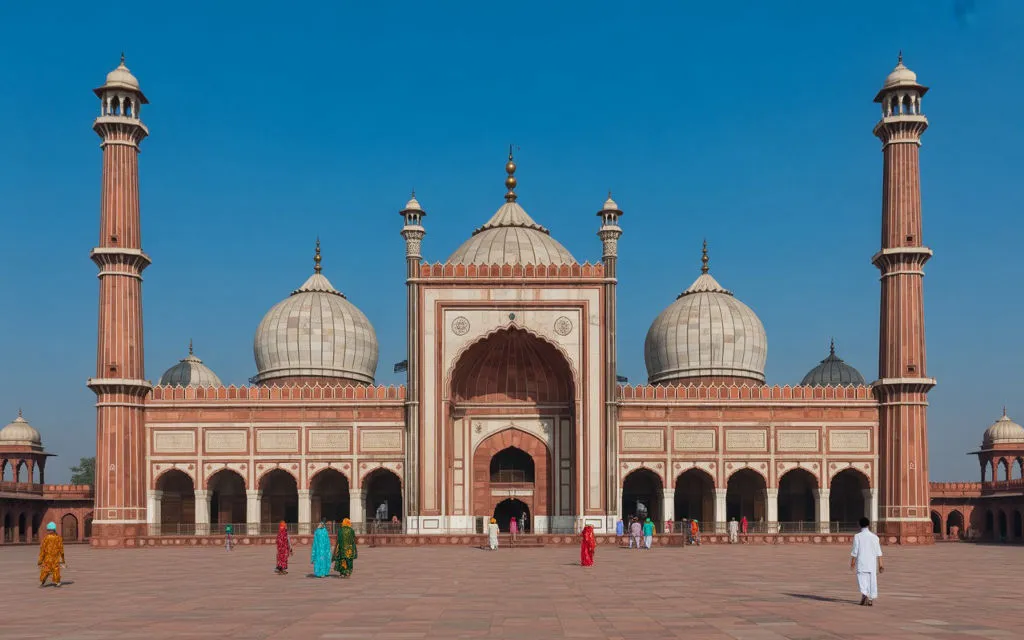
Lotus Temple
Lotus Temple, South Delhi, is the architectural wonder of the world with the message of peace and unity. Finished in 1986, it came under the Bahá’í Faith and is open for people of all religions spreading universal brotherhood. An Iranian architect, Fariborz Sahba, designed the temple to be as a blossoming lotus having 27 pure white marble petals clustered together. Beautifully set against the backdrop of green gardens and mirrored pools, the serene surroundings create an illusion of its spirituality. Silence in the interiors cuts down the noise pollution to meditate and pray, giving visitors the impression of being turned inwards to deep calmness. It presents in a modern age the harmony and inclusiveness nature speaks of.

Humayun’s Tomb
Tomb of Humayun, built by Empress Bega Begum in 1570 AD, marks the beginning of Mughal architectural magnificence in India. This UNESCO site inspired several later monuments, including the Taj Mahal. Designed by Persian architect Mirak Mirza Ghiyas, the tomb is set between beautifully landscaped gardens in the Charbagh style divided by water channels representing paradise. The square structure, being red sandstone in color and ornamented with white marble, represents the perfection of geometry and balance in symmetry. Humayun and several other Mughals are buried here, making it an important historical complex. Grandeur, lush greenery, and an air of tranquillity make it a worthy visiting landmark that reflects Mughal artistry’s grandeur.
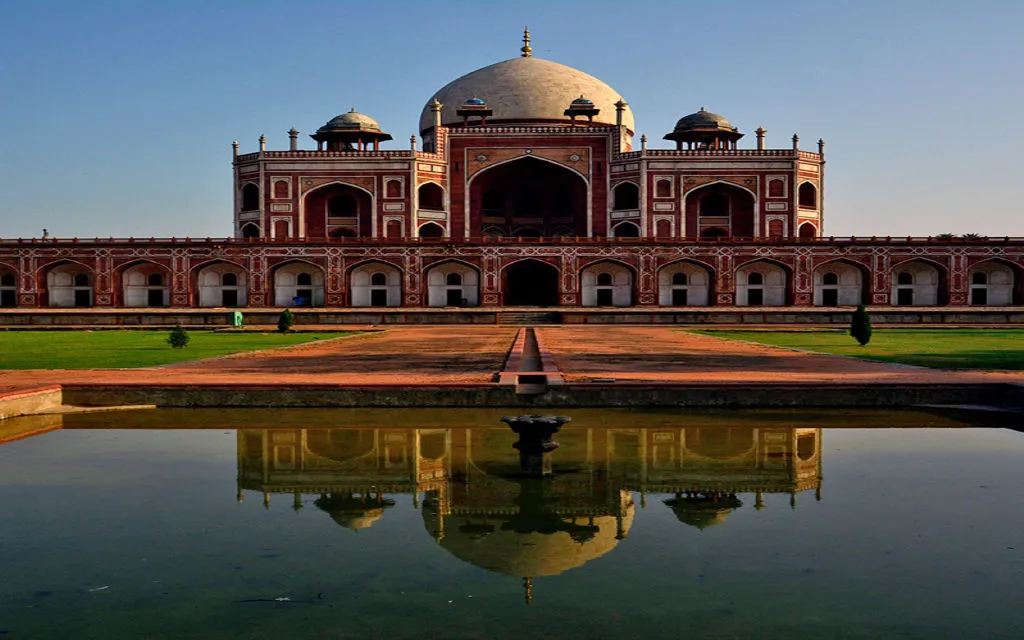
Qutub Minar
At a towering height of 73 meters, Qutub Minar comes under the classification of being the tallest brick minaret as well as one of the most representative symbols of Delhi. It was commissioned in 1192 by Qutb-ud-din Aibak but was later completed by Iltutmish and Firoz Shah Tughlaq. The tower was built in red sandstone and marble. It holds some of the finest carvings and inscriptions of the Quran within, reflective of what Indo-Islamic arts once were in the early years. That is coupled with its five tapering storeys – each marked by a projecting balcony – showcasing the artistic brilliance and craftsmanship of medieval India. The Qutub Complex integrates ancient ruins like the late-built Quwwat-ul-Islam Mosque and an extraordinary Iron Pillar that increases the number of cultural and historical dependencies surrounding it.

India Gate and Rajpath
Built along the ceremonial boulevard by which Rajpath runs, the India Gate is a national monument commemorating the sacrifices of more than 84,000 Indian soldiers during World War I and the wars in Afghanistan. Designed in 1931 by the British architect Sir Edwin Lutyens, it has all the essential features of the Arc de Triomphe of Paris. The height of this monument is 42 meters, and it is surrounded by beautiful gardens and fountains which create a peaceful atmosphere. Beneath it lies the Amar Jawan Jyoti, an eternal flame in honor of India’s unknown soldiers. Every year Rajpath transforms into a huge avenue for hosting parades that are indeed grand and have their significance in patriotism, unity, and India’s spirit of valor and pride down the ages.

Suggested Experience: A half-day heritage walk through Old Delhi, further taking you back to New Delhi, arranged by Go India Holidays with guided sightings and local insights.
2. Agra: The City of Eternal Love
Agra, the city that immortalized love through its timeless monuments, is one of India’s most enchanting destinations. Known for its splendid Mughal architecture, rich history, and romantic aura, Agra forms the heart of the Golden Triangle Tour. Every corner of this city whispers tales of emperors and eternal devotion. From the white marble magnificence of the Taj Mahal to the grand fortresses and serene gardens along the Yamuna River, Agra offers a journey through India’s glorious past. It’s not just a city—it’s a living museum of love, artistry, and royal heritage that continues to fascinate travelers from around the world.
Taj Mahal
The Taj Mahal, one of the Seven Wonders of the World, stands as the ultimate symbol of love and devotion. Built by Mughal Emperor Shah Jahan in memory of his beloved wife Mumtaz Mahal, this masterpiece of white marble glows in different hues throughout the day—rosy at dawn, pearly white at noon, and golden under moonlight. Intricate carvings, calligraphy, and symmetrical gardens make it an architectural marvel. Beyond its beauty, the Taj Mahal captures the soul of romance and eternal remembrance. Visiting this monument is not just sightseeing—it’s an emotional experience that connects one to India’s royal and cultural essence.
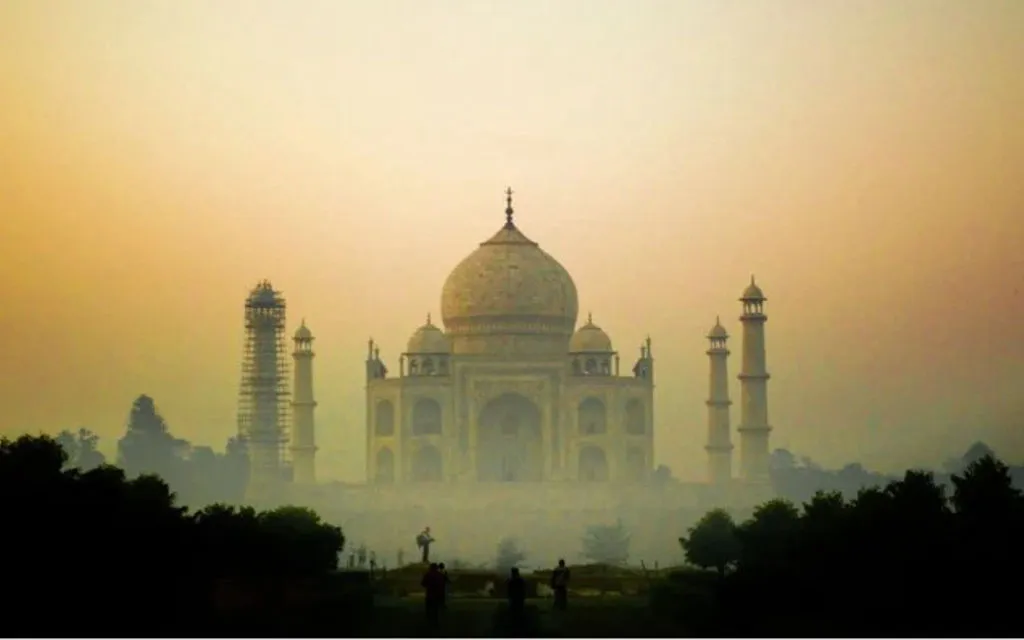
Agra Fort
A UNESCO World Heritage Site, the Agra Fort is a massive red sandstone structure that showcases the military strength and artistic grandeur of the Mughal Empire. Commissioned by Emperor Akbar in 1565, it served as both a fortress and royal residence. Within its imposing walls lie elegant palaces, mosques, and audience halls such as the Diwan-i-Aam and Diwan-i-Khas. Later, Shah Jahan added beautiful marble touches, making it a blend of power and poetry in stone. From its ramparts, one can enjoy stunning views of the Taj Mahal, adding an emotional depth to the fort’s historic and architectural brilliance.
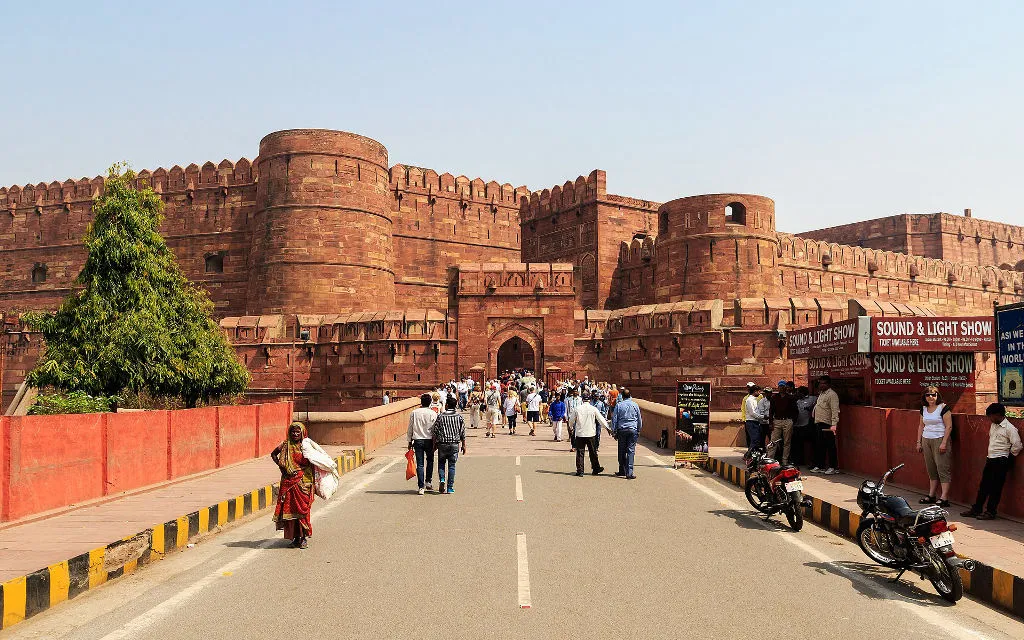
Mehtab Bagh
Mehtab Bagh, meaning “Moonlight Garden,” lies across the Yamuna River, perfectly aligned with the Taj Mahal to offer breathtaking sunset and moonlit views. Originally built by Emperor Babur and later restored by Shah Jahan, the garden was designed as part of the Taj complex. Its charbagh-style layout, with reflecting pools and symmetrical paths, offers one of the most romantic vantage points of the Taj. Away from the crowds, Mehtab Bagh provides tranquility and a chance to see the Taj Mahal mirrored in the river’s waters—creating an ethereal experience that captures the essence of Agra’s timeless beauty and serenity.
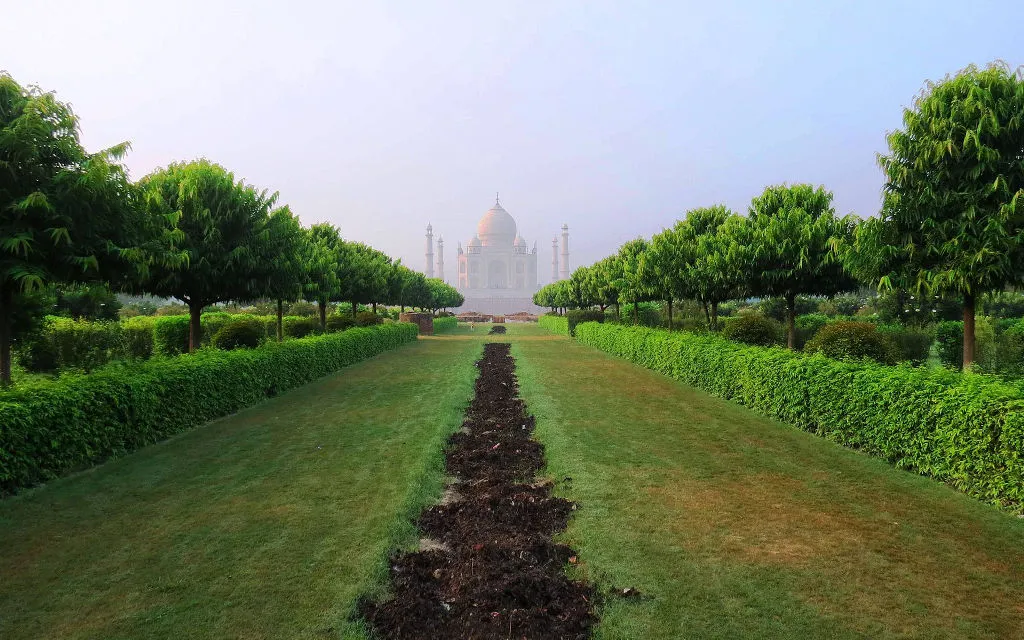
Fatehpur Sikri
A short drive from Agra lies Fatehpur Sikri, a perfectly preserved Mughal city and UNESCO World Heritage Site. Founded by Emperor Akbar in the 16th century, it served as the empire’s capital for nearly 15 years. This ghost city showcases a stunning fusion of Hindu, Persian, and Islamic architectural styles. Notable landmarks include Buland Darwaza, Panch Mahal, and the marble tomb of Salim Chishti, revered for its spiritual aura. Despite being abandoned due to water scarcity, Fatehpur Sikri remains a captivating reminder of Akbar’s vision, artistry, and grandeur—an open-air museum of Mughal excellence frozen beautifully in time.
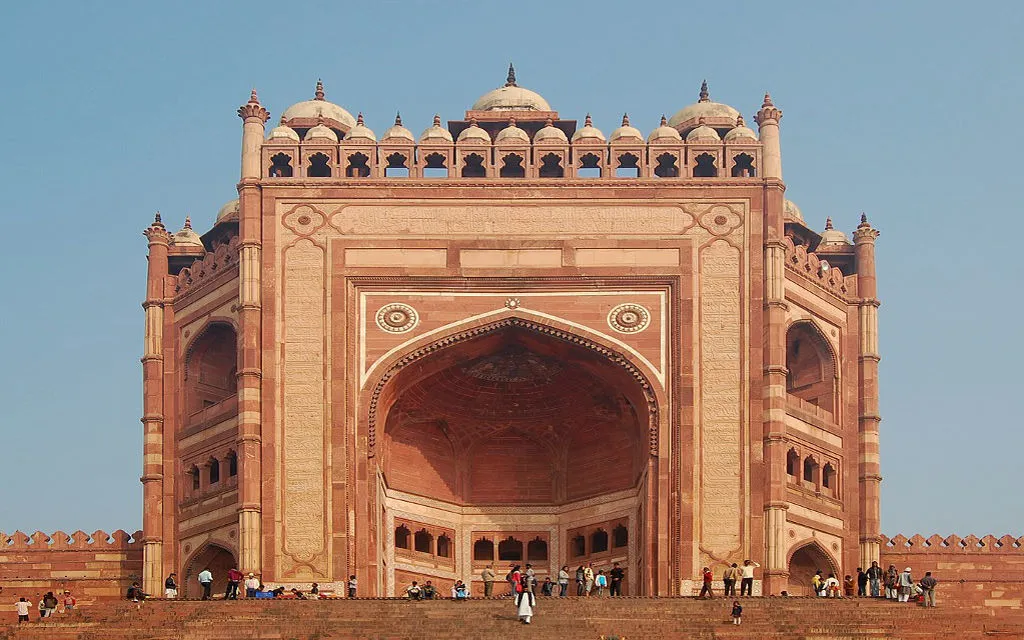
Suggested Experience: Sunrise Taj Mahal tours with professional photography and heritage walks through Old Agra, provided by Go India Holidays.
3. Jaipur: The Royal Pink City
Known as the Pink City, Jaipur is the vibrant capital of Rajasthan and a dazzling blend of royalty, tradition, and artistry. Founded in 1727 by Maharaja Sawai Jai Singh II, the city’s pink-hued buildings symbolize hospitality and charm. Jaipur is famed for its majestic forts, ornate palaces, and lively bazaars filled with handicrafts, textiles, and gemstones. As the final jewel of India’s Golden Triangle Tour, Jaipur offers travelers a rich cultural experience that blends regal heritage with modern vibrancy. Every street, monument, and market reflects the grandeur of Rajput kings and the city’s timeless spirit of color, craftsmanship, and culture.
Hawa Mahal
The Hawa Mahal, or “Palace of Winds,” is Jaipur’s most iconic landmark, built in 1799 by Maharaja Sawai Pratap Singh. Its unique façade, with 953 small latticed windows (jharokhas), allowed royal women to observe street festivals and daily city life without being seen, maintaining the customs of purdah. Crafted from red and pink sandstone, the five-storey structure resembles Lord Krishna’s crown and glows beautifully in the morning sunlight. Its intricate honeycomb design also provides natural ventilation, keeping the interiors cool. Overlooking the bustling Johari Bazaar, the Hawa Mahal perfectly captures Jaipur’s blend of architectural genius, royal elegance, and vibrant charm.
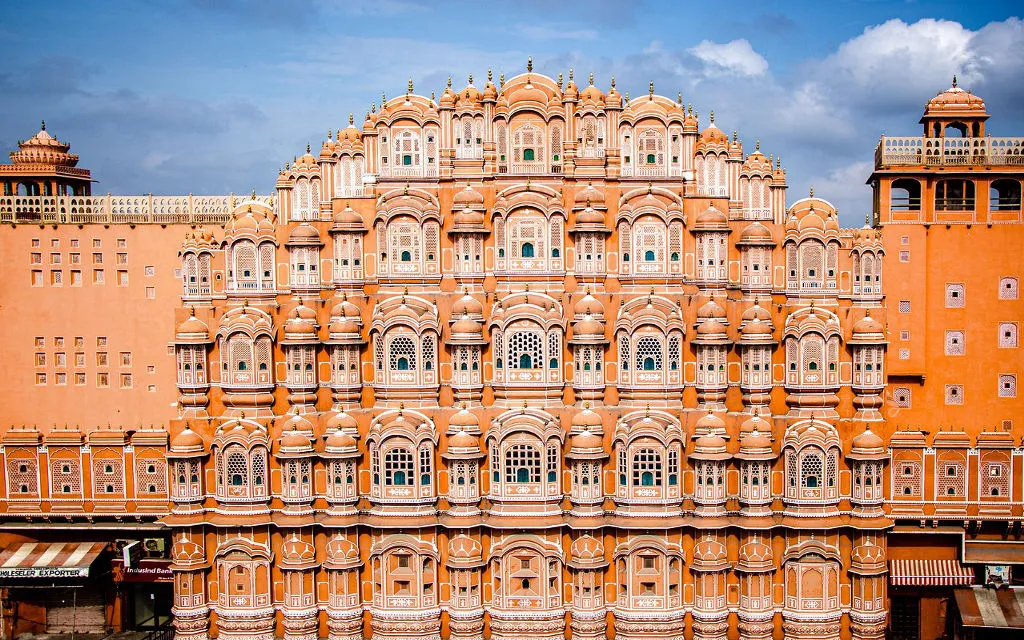
Amber Fort
Perched majestically on a hill overlooking Maota Lake, Amber Fort (or Amer Fort) is one of Rajasthan’s most stunning architectural masterpieces. Built in the 16th century by Raja Man Singh, this UNESCO World Heritage Site combines Rajput and Mughal design elements. The fort’s marble and sandstone walls house grand courtyards, artistic mirror work, and ornate frescoes. Highlights include the Sheesh Mahal (Mirror Palace), Ganesh Pol gateway, and panoramic views of the surrounding hills. Visitors can enjoy an elephant ride or a light-and-sound show that narrates the fort’s royal past. Amber Fort embodies Jaipur’s royal spirit, grandeur, and timeless architectural brilliance.
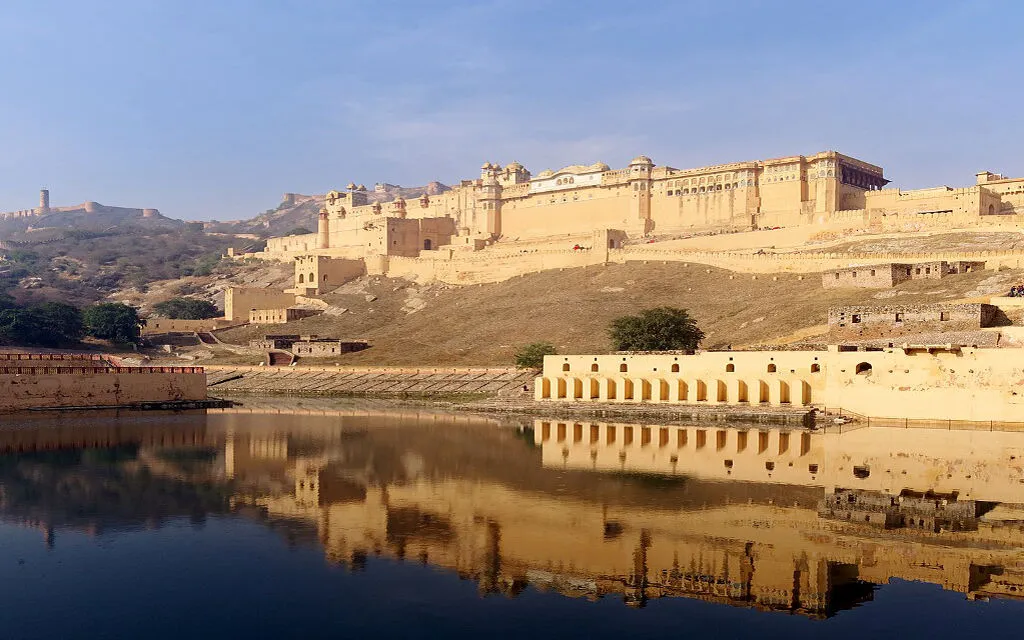
City Palace
The City Palace stands at the heart of Jaipur, representing the royal family’s legacy and lifestyle. Built by Maharaja Sawai Jai Singh II, the palace complex blends Mughal and Rajput architecture, featuring elegant courtyards, pavilions, and gardens. The Chandra Mahal and Mubarak Mahal within the complex house museums displaying royal costumes, weapons, manuscripts, and art. Part of the palace remains the royal residence even today, offering a glimpse into regal traditions. The exquisite Peacock Gate, adorned with intricate motifs, is a highlight. Visiting the City Palace allows travelers to experience Jaipur’s royal heritage and the splendor of its living monarchy.
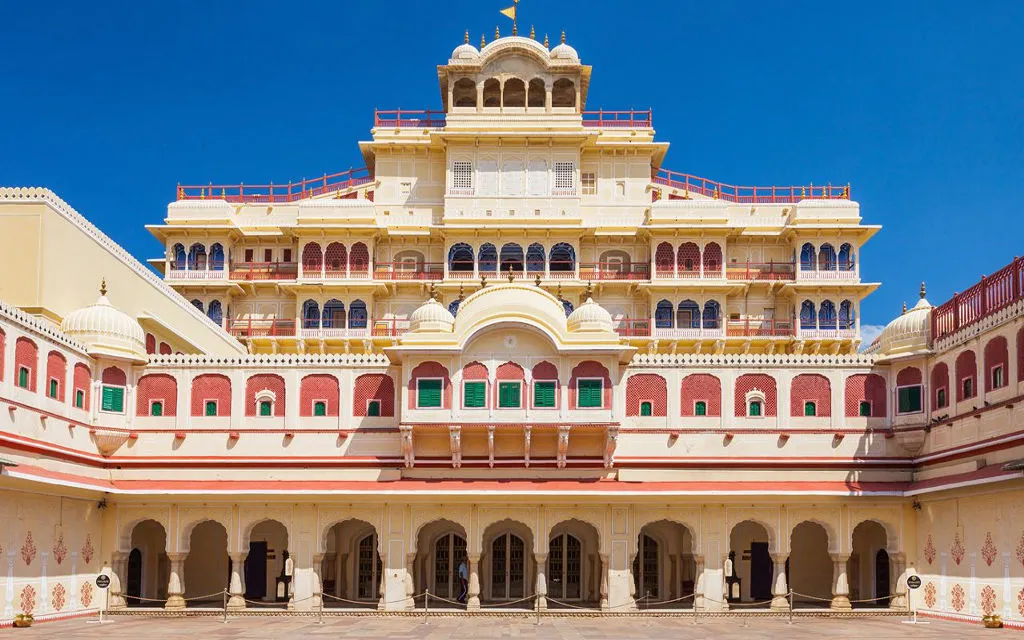
Jantar Mantar
A UNESCO World Heritage Site, Jantar Mantar is an extraordinary collection of 19 astronomical instruments built by Maharaja Sawai Jai Singh II in the early 18th century. Designed for naked-eye observations of celestial bodies, it remains one of the world’s largest and best-preserved observatories. The instruments measure time, predict eclipses, and track stars with remarkable precision. The centerpiece, the Samrat Yantra (a giant sundial), accurately calculates time to within seconds. Jantar Mantar reflects Jaipur’s scientific advancement and the Maharaja’s deep interest in astronomy and mathematics, offering visitors a rare combination of scientific ingenuity and architectural excellence.

Nahargarh and Jaigarh Forts
The twin forts of Nahargarh and Jaigarh stand guard over Jaipur, offering panoramic views of the city and surrounding Aravalli hills. Nahargarh, meaning “Abode of Tigers,” was built in 1734 as a royal retreat, while Jaigarh served as a military stronghold housing the world’s largest cannon on wheels, the Jaivana. Both forts are connected by underground passages and share fascinating tales of Rajput valor and defense strategies. Their walls, watchtowers, and palaces reflect traditional Rajput architecture. At sunset, the forts present breathtaking views of Jaipur’s pink skyline, making them must-visit destinations for history lovers and photography enthusiasts alike.

Albert Hall Museum
The Albert Hall Museum, located in the heart of Jaipur, is a stunning example of Indo-Saracenic architecture. Completed in 1887, it was designed by Sir Samuel Swinton Jacob and named after King Edward VII (then Prince Albert). The museum houses an extensive collection of artifacts, including paintings, sculptures, jewelry, carpets, and ancient weapons. Its Egyptian mummy and rare metalwork are among the highlights. Surrounded by Ram Niwas Garden, the museum looks especially enchanting when illuminated at night. The Albert Hall not only preserves Rajasthan’s artistic heritage but also offers a cultural journey through India’s diverse history and royal craftsmanship.
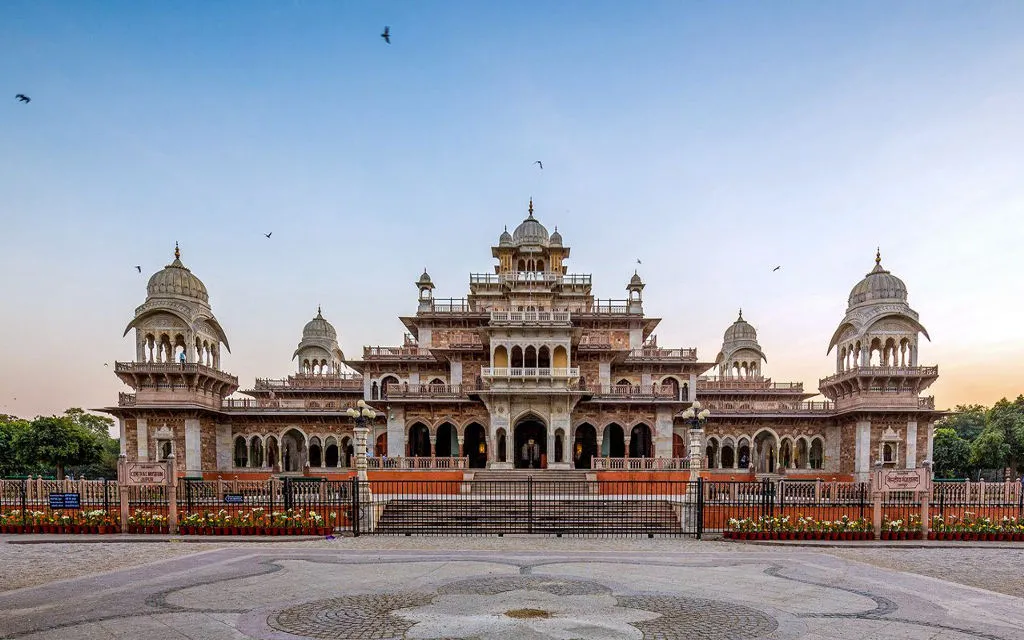
Suggested Experience: A Go India Holidays Jaipur city tour, which would include shopping in local markets and cultural dining at Chokhi Dhani.
Travel Tips for Exploring India's Best Tour—The Golden Triangle
Follow travel tips by our advisors to make your Golden Triangle in India enjoyable.
1. Plan Your Route Properly
The Delhi Agra Jaipur tour could be done in a clockwise or anti-clockwise itinerary. Clockwise would be Delhi→Agra→Jaipur→Delhi, and vice versa. Both roads offer great connectivity through beautiful expressways.
2. Choose Your Duration Wisely
Guests going for the first time should prefer the 6-7 days tour. If time permits, just keep adding places like Ranthambore, Pushkar, or Udaipur.
3. Pack Smart
Carry comfortable walking shoes, light cotton clothes for daytime, plus a light jacket for chilly evenings (especially if traveling from October to February). Sunscreen, hats, and a reusable water bottle would also be good options.
4. Respect Local Customs
Respect local customs-dress modestly when entering temples and mosques. Always take your shoes off before entering any place of worship.
5. Hire Local Guides
Go India Holidays has licensed English-speaking guides who will unlock for you sites and cultures.
6. Taste Local Cuisine
Sample local specialties:
- Delhi: Paranthas, Butter Chicken, and Chaat
- Agra: Mughlai curries, Petha sweets
- Jaipur: Dal Baati Churma, Laal Maas, and Ghewar desserts
7. Stay Hydrated and Safe
With the hot climate in India, drink bottled water, avoid street foods, and keep some light snacks while sightseeing.
8. Endeavor for Responsible Shopping
Bargaining is accepted but with a smile. Always aim for genuine handicraft shops suggested by Go India Holidays.
9. Capture the Moments
Most monuments allow it, but you can check for local restrictions. Early morning and sunset will offer picture-perfect photographic opportunities.
10. Trust Your Operator
To ensure that you smoothly sail through, Go India Holidays, a name known for customized itineraries and professional service, is the best choice for booking your Golden Triangle India Tour.
Frequently Asked Questions
So, for travelers wishing to set out on Gold Triangle Tour in India, they only seem to have that one question to each and every travel agent, capturing all FAQs in Go India Holidays at least to answering each with so much personal clarity and care so that even everyone can understand before going out doing things related to travel.
Every single city from the tour of Delhi Agra Jaipur will have quite an array of options of accommodation value at different price ranges-from lows for economy hotels to luxury resorts of world quality.
- Delhi: Some of the best international brands in hotels include Lalit, Taj Palace, and The Leela Ambience. Boutique hotels are popular in Connaught Place and South Delhi.
- Agra: Here come those romantic lodges like ITC Mughal, Oberoi Amarvillas (with direct vision views of Taj Mahal), while in the mid-range there are lodges like Crystal Sarovar Premier.
- Jaipur: Enjoy the charm of palatial heritage stays at Rambagh Palace, Samode Haveli, or surprisingly charming heritage hotels within Pink City itself.
Go India Holidays helps you select the best stay in terms of comfort, budget, and proximity to attractions. All partner properties are verified for cleanliness, safety, and standards of hospitality.
The very soul of the experience behind the Golden Triangle India is the food and culture of each city having its intrinsic flavors signed and duly submitted to special traditions.
- Delhi: Spicy chaat and kebabs with stuffed paranthas in Old Delhi; grand dining Mughlai and North-Indian dishes in New Delhi.
- Agra: Mughlai curries, tandoori wonders, and sweet Petha are then supplemented by outdoors rooftop dinners having wonderful views of the amazing Taj Mahal.
- Jaipur: Real Rajasthani Cuisine- Dal Baati Churma, Laal Maas, Ghewar- with folk music, puppet shows, and camel rides.
Go India Holidays might also organize food walks, kitchen classes or cultural evenings with deeper penetration wherein the travelers would meet the local artisans and performers.
Yes! The Golden Triangle Tour India is safe for families; distances between destinations are short, with very good roads making travel comfortable. There is much of interest to appeal to all ages; for adults or children, there’s something alluring about places like Taj Mahal and the beautiful palaces of Jaipur.
Go India Holidays offer specially designed packages for families which include child-friendly guides with meal plans flexible to add enjoyment or wildlife as optional.
Absolutely! You can extend your itinerary for Golden Triangle very comfortably by adding other nearby destinations:
Ranthambore National Park: For those interested in tiger sighting safaris.
Pushkar & Ajmer: For spiritual and cultural extensions.
Udaipur: The romantic city of lakes in the state of Rajasthan.
Varanasi: To witness India’s spiritual essence on the Ganges.
Go India Holidays specializes in customizing such tailor-made tour extensions as per your interest, time, and travel style.
The safest travel circuits made for tourists in India are these Hermitage by very cautious standards. Pre-booking hotels automatically gives travelers ease of mind in that they now have licensed guides while Go India Holidays customer service opens to full operation 24 hours a day, seven days a week. Local authorities and their tourism infrastructure are very developed to ensure international visitors feel at ease.
Valid passport, Indian tourist visa, and travel insurance are compulsory for foreign travelers, while Indian domestic travelers just need valid ID proof. Go India Holidays provides pre-arrival guidance, airport assistance, and complete documentation support for a hassle-free experience.
Map of the Golden Triangle (Visual Element)
📍 Delhi → Agra → Jaipur → Delhi
The map describes the triangular route connecting: Delhi (North): Political & Cultural Capital Agra (Southeast): Mughal Heritage & Taj Mahal Jaipur (Southwest): Royal Capital of Rajasthan Each leg of the journey is around 200-250 km.
Delhi to Agra via Yamuna Expressway (~3.5 hrs)
Agra to Jaipur: via NH21 (~5 hrs)
Jaipur to Delhi: via NH48 (~5.5 hrs)
Conclusions
The India Golden Triangle Tour is by far more than a sightseeing circuit. It is the very soul of India, captured within one unforgettable journey, from the Mughal majesty of Delhi to the eternal romance of Agra and the royal charm of Jaipur. The triangle reflects every hue of India’s history, art, and culture, from their best corners.
This is a tour that’s perfect for giving the traveler the absolute first flavor of Indian society-from a monument that beats the world, fabulous traditions, mouth-watering cuisine, and genuine hospitality. Timeless and very enriching, each experience along all tours of Delhi Agra Jaipur can count for being someone’s first.
Travel is meant to be seamless, meaningful, and memorable according to us at Go India Holidays. Our expert team curates personalized Golden Triangle India packages that merge together comfort, authenticity, and adventure. Private transfers, tour guiding, heritage stays, and cultural experiences are some of the many details well-thought-out.
Why Choose Go India Holidays?
- Over 10 years in inbound tourism in India.
- Handpicked guides and drivers attributed or verified.
- Flexible itineraries-luxury escapes or budget tours.
- 24×7 customer assistance and full disclosure on pricing.
- So, if you want to see the Taj Mahal at sunrise or visit Delhi’s vibrant bazaars, let Go India Holidays make that dream a reality by walking through the royal corridors of Jaipur.
- Plan Your Travel Today!
- Speak to Go India Holidays Custom Plan your Golden Triangle Itinerary, and see why this route is the most traveled in India.

